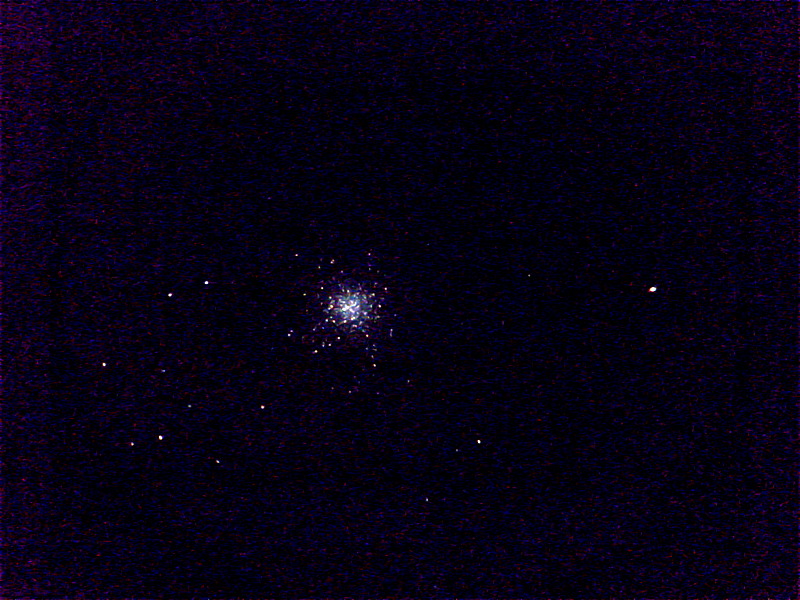iPhone 6s Plus arrived; iPhone & D7200 imaging;
Asteroid 2015 TB145
Posted: 31 October 2015
Tuesday, 27 October 2015, dawned clear, but with another storm system approaching clouds began appearing during the day. On the good news front, I finally received a new iPhone 6s Plus to upgrade from my iPhone 5s. Then the wait began for clear skies to do some iPhone 6s Plus astrophotography with the Orion SteadyPix afocal adapter and finally finish my review. I also had to get a new "Joby GripTight Mount XL for Smartphones" for the larger iPhone 6s Plus so that I could mount it on my GorillaPod:

I had previously discussed the GorillaPod in April 2014 and February 2015.
The storm system finally arrived before dawn on Thursday, 29 October. Several thunderstorms occurred during the day. This partial rainbow was seen mid-afternoon (1448 MST):

The sun was so high in the sky that when I first saw the rainbow it was a double rainbow with the secondary bow right below the primary bow, instead of appearing well separated from it. Wish I could have photographed that but it faded by the time I got outside. Only received 0.19" of rain from the day's storms.
Light rain continued Friday morning, with a total of 0.13" before the sky began to clear mid-day. But while I was taking an afternoon nap in anticipation of an all-nighter in the observatory (for the close pass of asteroid 2015 TB145) a rainshower came through, dropping another 0.01". Went to the observatory about an hour before sunset to wipe off the water from the dome. The sky was still mostly cloudy after sunset, but finally cleared a couple of hours later.
|
Open: Friday, 30 October 2015, 2002 MST Temperature: 55°F |
Session: 872 Conditions: Clear, humidity 58% |
I needed to wipe some dew from the observatory dome before I opened the dome. 2016 MST: viewed Neptune, 83X. Then slewed to M57 (Ring Nebula) for my first iPhone 6s Plus astrophoto. Mounted the SteadyPix afocal adapter (77X) and used NightCap Pro for these images (Long Exposure, Light Boost, ISO 8000, 1/3sec, 1 minute exposure):
M57 Ring Nebula

M13 Great Hercules Globular Cluster

Double Cluster

I hope to finish my review of the Orion SteadyPix after my next session in the observatory. I will also be updating my NightCap Pro review.
2041 MST: eastern sky brightening from the rising waning gibbous Moon. 2053 MST: began testing the iOS app "ScopeBoss" on the iPhone 6s Plus. My ScopeBoss review has been updated with comments on using it with the iPhone 6s Plus.
2104 MST: viewed Neptune and then Uranus, 83X. Began setting up for D7200 DSLR imaging of the planets. I wanted to try HD video recording, 1.3X crop factor, 60fps at prime focus of the 8" plus the 2X PowerMate. At 1/60sec, ISO 25600, Neptune was too underexposed to yield any usable frames. Uranus was nearly too underexposed and I could not stack the video frames. However, this single frame (cropped) shows Uranus:

2133 MST: the Moon was now above the hill to the east but was too low for good imaging. And according to SkySafari Pro on my iPhone 6s Plus, NEO asteroid 2015 TB145 was also now above the hill. 2158-2215 MST: took a short break from the observatory.
Upon returning to the observatory I used the D7200 DSLR for these prime focus + 2X PowerMate images:


Removed the DSLR and PowerMate, and mounted the iPhone 6s Plus using the SteadyPix for this afocal 77X image:

2233 MST: quick look at the Moon, 83X. Then powered on the GC Wi-Fi Adapter and used SkySafari Pro to GOTO asteroid 2015 TB145. 2236 MST: began watching for asteroid movement at 77X. 2243 MST: asteroid sighting confirmed. Asteroid motion against background stars was very obvious once the asteroid was seen. The asteroid was faint to the eye but was definitely visible. Began setting up to image the asteroid at 8" LX200-ACF prime focus with the D7200 DSLR. I took several images of the asteroid over the next two hours. This image was taken at 2310 MST, 20 seconds, ISO 6400:

This animated GIF shows the motion of the asteroid at one minute intervals beginning at 2310 MST:

By midnight the humidity was over 60%. My logbook paper was getting damp. At 0045 MST, as I began to take another series of asteroid images, the telescope stopped responding to commands from SkySafari Pro and from the AutoStar handcontroller. For some reason the electronics in the mount had locked up. That had never happened before with my 7 year old LX200-ACF. I will have to check that out during the daytime. Hopefully it is nothing serious and was just a temporary glitch. I decided to play it safe and powered off the telescope and began closing up the night.
|
Close: Saturday, 31 October 2015, 0104 MST Temperature: 48°F |
Session Length: 5h 02m Conditions: Clear, humid |
Comments are welcome using Email. If you are on Twitter you can use the button below to tweet this report to your followers. Thanks.
Cassiopeia Observatory Home Page
Copyright ©2015 Michael L. Weasner / mweasner@me.com
URL = http://www.weasner.com/co/Reports/2015/10/31/index.html
